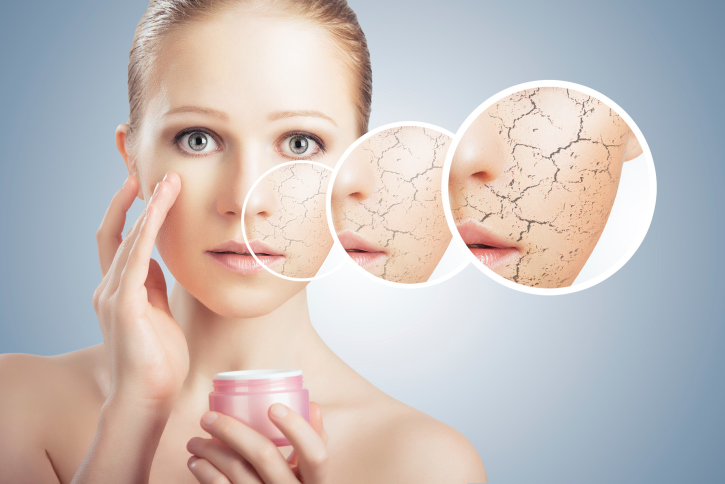Dry skin: the role of pharmacy
Record learning outcomes
This educational content can be used to train your pharmacy team and act as a refresher on the topic of dry skin, a common condition that can be effectively managed using products available from pharmacy
Skin function and structure
The skin consists of layers and performs many functions. It protects the internal tissues from UV light, temperature variations, dehydration (or over-hydration), toxins, bacteria and trauma. The skin is also important in the production of vitamin D and acts as a sensory organ for pain, temperature and touch.
Epidermis (outer layer)
This consists of stratified squamous epithelial cells, the outer layers of which are dead cells. They form a hard, waterproof layer – the stratum corneum (horny layer). There are four layers beneath this that are formed as the keratinocyte cells migrate up towards the skin surface from the basal layer, undergoing changes as they go. Where there is friction, this stimulation produces a thicker layer; for example on the soles of the feet.The cells in the stratum corneum are bound together by epidermal lipids. If there is a lack of lipids, the skin can become dry. The skin is kept supple by a film known as the hydrolipid film, an emulsion of water and lipids, maintained by excretions from the sweat and sebaceous glands.
Dermis
This layer provides support and nutrients to the epidermis. There are two layers: the papillary and the reticular layer. Substances such as elastin, fibrillin and collagen are found within the dermis. The dermis also contains sweat and sebaceous glands, hair follicles, nerve endings and blood vessels. The sebum excreted by the sebaceous glands helps to keep the skin moist.
Hypodermis
This provides support for the dermis and is made up mostly of connective and fatty tissue. It is essential in the protection of internal organs and also provides insulation.
Changes in skin moisture levels cause a reduction in the barrier function, which then results in further water loss. An impaired skin barrier also allows the penetration of irritants/allergens.
Dry skin
Dry skin affects millions of people, particularly children aged under 10 years and those aged over 60 years. Generally, more women than men are affected by dry skin. It occurs when there is a lack of water in the epidermis and areas commonly affected include the hands, arms and the lower legs.
The symptoms of dry skin include a sensation of skin tightness, irritation, scaling and itchiness. Cracking and scratching the skin can cause damage and may lead to secondary infection. There are a variety of external and internal factors that may contribute to dry skin, including:
- Weather/temperature/humidity – particularly in winter with the central heating inside and cold air outside
- UV exposure
- Detergents/other chemicals or harsh soaps
- Certain medication such as diuretics
- Smoking – reduces the skin’s elasticity by affecting collagen
- Alcohol – due to its dehydrating effect
- Genetic predisposition
- Hormonal influences
- Age – sebum production decreases with age
- Diet – a lack of nutrients/ vitamins may affect the skin
- Illnesses such as psoriasis, hypothyroidism and atopic eczema.
Eczema
Eczema (dermatitis) is an inflammatory skin condition. There are different types of eczema including atopic (a predisposition toward developing certain allergic hypersensitivity reactions), irritant contact dermatitis (e.g. a reaction to detergents) or allergic contact dermatitis (e.g. an allergic reaction to nickel).
Atopic eczema is the most common type and it usually involves dry skin as well as infection and lichenification. It is a chronic skin condition that affects skin on the face and body of babies, children and adults. The cause is not known, but there are links with asthma and hay fever.
Although it cannot be cured, keeping the skin moisturised with regular, liberal application of emollients can help to prevent flare-ups. The symptoms are dry, flaky, irritated and itchy skin with occasional flare-ups.
Babies are typically affected on the face and scalp (also known as cradle cap). Children who develop it after the age of two years might start with a rash on the body which is dry with itchy, scaly patches. The skin may appear bumpy, thickened and leathery.
Other common areas affected include the elbows, knees, wrists, ankles, buttock creases and legs. Adults may have dry, scaly skin and also a non-stop itch on the face and body.
Treatment options
Emollients
For dry skin and eczema, regular use of emollients is key. Emollients soothe and relieve the skin, forming an oily layer over the skin surface, which traps water. Products are designed that target specific areas, such as the face, scalp, feet, hands or body and in different formulations such as oils, creams, ointments or emulsions. Emollients should be smoothed onto the skin in the direction of hair growth. They should be applied immediately after washing/ bathing.
Other ingredients may be found in combination with emollients:
- Humectants such as urea/ lactic acid
- Urea is one of the substances produced naturally by the skin to regulate moisture content. As such, it is a well-tolerated ingredient. It is keratolyic (breaks down the connection between dead skin cells, improving the shedding), a keratin softener and a hydrating agent that is used in the treatment of dry, scaling conditions. It is hygroscopic (binds water in the stratum corneum), helping to maintain moisture balance and suppleness. Urea helps to reduce the cycle of itching and irritation caused by dry skin, as well as reducing moisture loss. If the skin is very dry, a higher content of urea (10 per cent) may be recommended.
- Lactate is also produced naturally by the skin, and absorbs and retains moisture in the stratum corneum.
- Anti-itch agents such as lauromacrogols or oatmeal
- Ceramides to restore lipid balance.
Managing eczema flare-ups
Cleansing and care products containing emollients should still be used during a flare-up. A mild topical hydrocortisone may be supplied OTC for adults and children over 10 years of age on a short-term basis (up to a week). It should be applied half-an-hour before emollients. Products containing liquorice extract to soothe redness and relieve inflammation may be useful.
Counselling points
- Soap substitutes can be used before contact with water to prevent stinging
- Bath/shower oil emollients are available – remind customers that they may make the bath/shower slippery
- Regular emollient use should continue even if the skin is clear
- Paraffin-based products can be flammable; customers should be advised to avoid naked flames
- Some customers may be irritated by additives such as colourants or fragrance in products, so should look for products that are free of these
- Have quick, warm showers instead of long, hot baths, and gently pat the skin dry before applying an emollient
- Use gloves when washing dishes
- Wear clothes made out of natural materials that are less likely to irritate the skin such as cotton or silk
- Drink plenty of fluids
- Skin creams could be kept in the fridge, as applying a cooled product can relieve itching.
EUCERIN® 100 YEARS OF INNOVATIVE SKIN SCIENCE
Eucerin is the dermatologist-recommended skincare brand based on honest skin science. By working with dermatologists and using advanced technological expertise, Eucerin® ensures reliable and highly effective product innovation to the highest dermatological standards.
The Eucerin® range of products are designed to be applied to different areas of the body and are formulated for either dry or very dry skin. You can recommend the most appropriate products to meet your customers’ needs.
TREATMENT
For dry skin conditions including xeroderma, atopic eczema, hyperkeratosis and ichthyosis.
• Enriched with urea and lactate to ensure long-lasting hydration
• Fragrance and colourant free
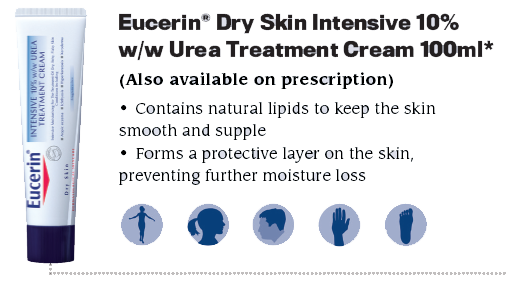
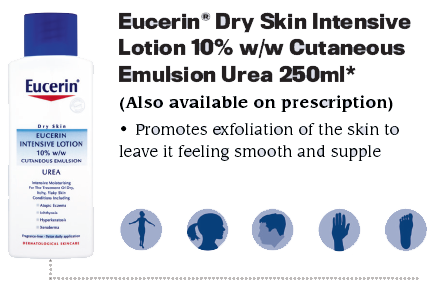
MANAGEMENT
For the management of dry skin, all the products below contain urea and lactate for long-lasting hydration. They are all fragrance and colourant free.
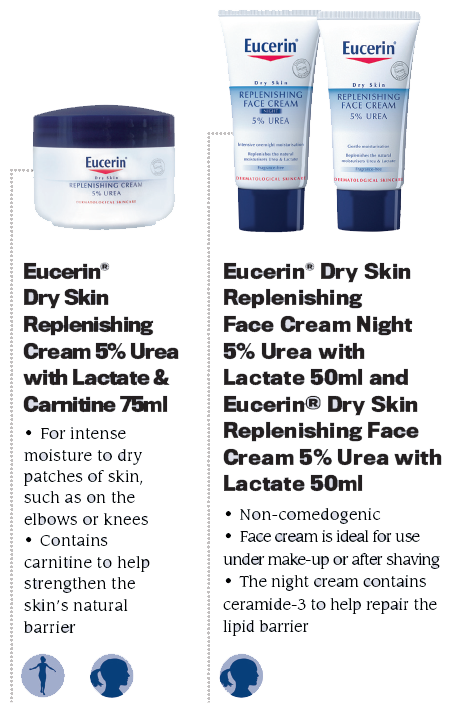
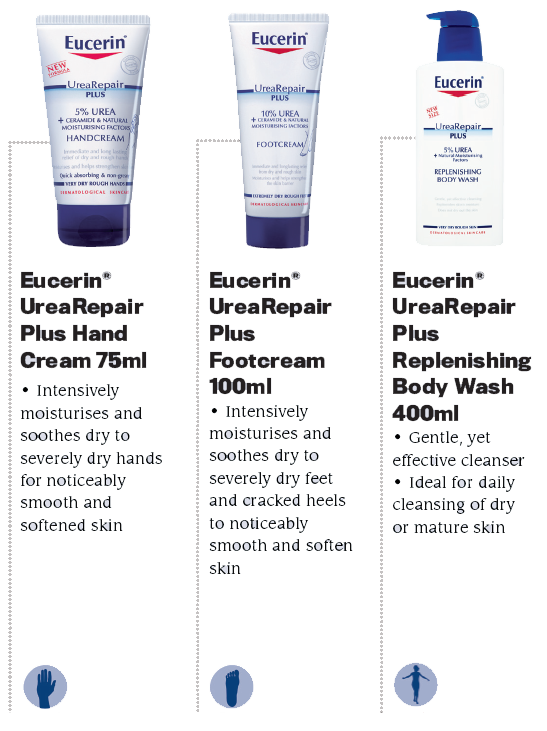
* Licensing product information relating to Eucerin® Intensive 10% w/w Urea Treatment Cream and Eucerin® Intensive Lotion 10% w/w Cutaneous Emulsion. Marketing authorisation holder: Beiersdorf UK Ltd, Birmingham B37 7YS, UK. Active ingredients: Urea EP 10% w/w. Directions: Apply twice daily to the affected areas of the skin. Indications: For the treatment of ichthyosis, xeroderma, hyperkeratosis and atopic eczema/dermatitis and other dry skin conditions. Precautions: Do not use if sensitive to any of the ingredients in cream or lotion. Do not use on broken, inflamed skin. Do not apply to large areas of skin on patients with renal insufficiency. This cream or lotion could increase the penetration of some substances, such as medicines known as corticosteroids, dithranol or fluorouracil. Avoid contact with the eyes or other sensitive areas. Keep out of reach of children. For external use only. Legal category: UK: GSL (PL: 14160/0003); ROI: P (PA 1159/1/1) for Cream and UK: GSL (PL14160/0004); ROI: P (PA1159/1/2) for the Lotion. NHS Price – Pack size and cost 250ml lotion (£7.93), 100ml cream (£7.59). To report any adverse reaction, please contact BDF Consumer Relations on 00 44 845 6448556. Eucerin® is a registered trademark. Revised September 2016.
This sponsored educational article has been developed in partnership with Eucerin

